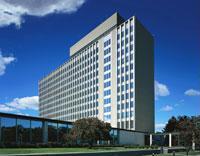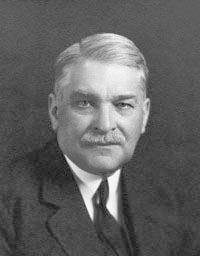National Institute of Standards and Technology
The National Institute of Standards and Technology (NIST) is a United States federal agency within the U.S. Department of Commerce.[1] The institute was founded in 1901 with the aim to advance measurement science, standards, and technology. NIST was known between 1901–1988 as the National Bureau of Standards (NBS).
NIST has four programs:
- NIST Laboratories.
- Baldrige National Quality Program.
- Hollings Manufacturing Extension Partnership.
- Technology Innovation Program (a program created in 2007 that commenced in 2008).
NIST has an operating budget of about $1.6 billion[2] and operates in two locations: Gaithersburg, Maryland, and Boulder, Colorado. NIST employs a staff of about 2,900 scientists, engineers, technicians, and support and administrative personnel. About 2,600 associates and facility users from academia, industry and other government agencies complement the staff.[3]
History
Article 1, Section 8 of the United States Constitution grants the U.S. Congress the power to "To coin money, regulate the value thereof, and of foreign coin, and fix the standard of weights and measures". In accordance with that, in June 1836, The U.S. Senate and the U.S. House of Representatives adopted a joint resolution establishing a U.S. Office of Weights and Measures within the U.S. Department of the Treasury. From that date until March 1901, the Office of Weights and Measures was administered mostly by the U.S. Coast Survey[4] within the U.S. Department of the Treasury.[5] Ferdinand Rudolph Hassler, a professor of mathematics, served as the head of U.S. Coast Survey as well as the Office of Weights and Measures from 1836 to 1843.[6][7]
In 1899, Henry Smith Pritchett (then head of the U.S. Coast and Geodetic Survey) was determined to bring the Office of Weights and Measures into line with the changing industrial and scientific needs for standards other than simply weights and measures. To that end, he asked Samuel W. Stratton, a physics professor at Chicago University (later to become president of the Massachusetts Institute of Technology), to help reorganize the Office of Weights and Measures. Stratton developed a comprehensive report on the need for a well-equipped national bureau of standards and outlined plans for establishing it.[8][9] The U.S. Congress adopted his ideas and enacted the Bureau of Standards Act in March 1901 which abolished the Office of Weights and Measures and created the National Bureau of Standards (NBS) within the U.S. Department of the Treasury. Stratton was appointed as its first director and he remained there for twenty-one years.[10]
In February 1903, the NBS was transferred to the U.S. Department of Commerce and Labor and renamed as the Bureau of Standards. In 1913, it was transferred to the U.S. Department of Commerce. Then in 1934, the word "National" was again affixed to its name. For more than 50 years, it remained as the National Bureau of Standards. Finally, in 1988, it became the National Institute of Technology, commonly referred to as NIST.[11][12]
NIST laboratories
The NIST laboratories are located in Gaithersburg, Maryland and Boulder, Colorado. The main laboratories are:
- Building and Fire Research Laboratory
- Center for Nanoscale Science and Technology
- Chemical Science and Technology Laboratory
- Electronics and Electrical Engineering Laboratory
- Information Technology Laboratory
- Manufacturing Engineering Laboratory
- Materials Science and Engineering Laboratory
- NIST Center for Neutron Research
- Physics Laboratory
- Technology Services
Before the move to Gaithersburg, many laboratories were located in what is now the University of the District of Columbia main campus.
Baldrige National Quality Program
The purpose of this program is to improve the performance of U.S. manufacturers, service companies, educational institutions, and health care providers. An important tool for achieving improvements is the annual Malcolm Baldrige National Quality Award, which is given for performance excellence and quality achievement. This award, the highest honor for organizational performance excellence in the U.S., was created on August 20, 1987 and is named for Malcolm Baldrige, who served as 26th Secretary of Commerce from 1981 until 1987.
Originally, three types of organizations were eligible: manufacturers, service companies and small businesses. This was expanded in 1999 to include education and health care organizations, and again in 2007 to include nonprofit organizations (including charities, trade and professional associations, and government agencies). From 1988 until 2007, 72 organizations have received Baldrige Awards.
Hollings Manufacturing Extension Partnership
Ernest Frederick Hollings was a U.S. Senator from 1966 until 2005. In 1988 he introduced the Technology Competitiveness Act. This legislation set up the Manufacturing Extension Partnership (MEP). The partnership program was started in 1990. Upon retirement of Senator Hollings, the program was renamed the Hollings Manufacturing Extension Partnership in his honor. MEP is a U.S. network of 350 not-for-profit centers, whose purpose is to provide services to small and medium sized manufacturers. The centers, serving all 50 States and Puerto Rico, are linked together through NIST. Centers are funded by federal, state, local and private resources. The centers provide manufacturers access to technology making it possible for them to compete globally. MEP's operating budget in 2006 was $104.6 million. MEP also received $4.5 million in special funding to support the needs of manufacturers that were directly affected by the 2005 hurricane Katrina.
Technology Innovation Program
On August 9, 2007 a new Technology Innovation Program (TIP) was started at NIST. The program was established "to support, promote, and accelerate innovation in the United States through high-risk, high-reward research in areas of critical national need." The primary mechanism of TIP is to give cost-shared research grants and contracts awarded on the basis of merit competitions.
In June 2008, TIP described its first project – “Advanced Sensing Technologies for the Infrastructure: Roads, Highways, Bridges and Water Systems.”
TIP announced in January 2009 nine projects for award, representing up to $88.2 million in new research, $42.5 million of it funded by TIP. Thirty-five research participants are involved in the nine projects. Nine of those 35 participants are universities with four joint ventures led by universities. Thus, TIP contributes to funding of university-industry research.
Budget funding
The NIST's total budget funding of $1,599,000,000 ($1.6 billion) for 2010 comes from various sources: [2]
- $857,000,000 from the Consolidated Appropriation Act of 2010 (U.S. Public Law 111-117)
- $50,000,000 from service fees
- $102,000,000 from other agencies
- $590,000,000 from the American Recovery and Reinvestment Act (U.S. Public Law 111-5) which must be spent in 2010
References
- ↑ National Institute of Standards and Technology website
- ↑ 2.0 2.1 NIST Budget, Planning and Economic Analysis: 2010 Pie Chart Description Link]
- ↑ General Information (NIST website)
- ↑ Later renamed as the U.S. Coast and Geodetic Survey (USCG&S)
- ↑ There were some time periods during which the U.S. Army and/or the U.S. Navy administered the USCG&S
- ↑ Ferdinand Rudolph Hessler
- ↑ A Historic Review of Weights and Measures in the United States
- ↑ David F. Noble (1979). America by Design: Science, Technology, and The Rise of Corporate Capitalism. Oxford Press. ISBN 0-19-502618-7.
- ↑ Science, American Association for the Advancement of Science, Vol. 21, January - June 1905, page 162
- ↑ Samuel Wesley Stratton, 1861-1931 from the libraries of the Massachusetts Institute of Technology (MIT)
- ↑ Records of the National Institute of Technology from the website of the U.S. National Archives
- ↑ From NBS to NIST from the NIST website


